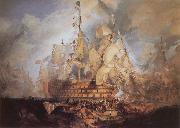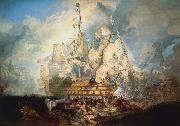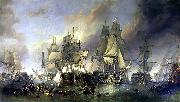Wholesale Oil Painting No Minimum |
|||||||||||
|
|
|||||||||||

|
|||||||||||
|
|
|
||||||||
J.M.W. TurnerEnglish Romantic Painter, 1775-1851 landscape master landscape master .British painter and printmaker. He dominated British landscape painting throughout the first half of the 19th century. He established a reputation in the Royal Academy, London, first as a topographical watercolourist and then within a few years as a painter of Sublime and historical landscapes. |
||||||||
|
|
||||||||
The Battle of Trafalgar
The Battle of Trafalgar Painting ID:: 53381 |
mk230
1824
Oil on canvas
259x365.8cm
mk230 1824 Oil on canvas 259x365.8cm |
|||||||
|
|
||||||||
Joseph Mallord William TurnerEnglish Romantic Painter, 1775-1851 Joseph Mallord William Turner (23 April 1775 ?C 19 December 1851) was an English Romantic landscape painter, watercolourist and printmaker, whose style is said to have laid the foundation for Impressionism. Although Turner was considered a controversial figure in his day, he is now regarded as the artist who elevated landscape painting to an eminence rivalling history painting. Turner's talent was recognised early in his life. Financial independence allowed Turner to innovate freely; his mature work is characterised by a chromatic palette and broadly applied atmospheric washes of paint. According to David Piper's The Illustrated History of Art, his later pictures were called "fantastic puzzles." However, Turner was still recognised as an artistic genius: the influential English art critic John Ruskin described Turner as the artist who could most "stirringly and truthfully measure the moods of Nature." (Piper 321) Suitable vehicles for Turner's imagination were to be found in the subjects of shipwrecks, fires (such as the burning of Parliament in 1834, an event which Turner rushed to witness first-hand, and which he transcribed in a series of watercolour sketches), natural catastrophes, and natural phenomena such as sunlight, storm, rain, and fog. He was fascinated by the violent power of the sea, as seen in Dawn after the Wreck (1840) and The Slave Ship (1840). Turner placed human beings in many of his paintings to indicate his affection for humanity on the one hand (note the frequent scenes of people drinking and merry-making or working in the foreground), but its vulnerability and vulgarity amid the 'sublime' nature of the world on the other hand. 'Sublime' here means awe-inspiring, savage grandeur, a natural world unmastered by man, evidence of the power of God - a theme that artists and poets were exploring in this period. The significance of light was to Turner the emanation of God's spirit and this was why he refined the subject matter of his later paintings by leaving out solid objects and detail, concentrating on the play of light on water, the radiance of skies and fires. Although these late paintings appear to be 'impressionistic' and therefore a forerunner of the French school, Turner was striving for expression of spirituality in the world, rather than responding primarily to optical phenomena. Rain, Steam and Speed - The Great Western Railway painted (1844).His early works, such as Tintern Abbey (1795), stayed true to the traditions of English landscape. However, in Hannibal Crossing the Alps (1812), an emphasis on the destructive power of nature had already come into play. His distinctive style of painting, in which he used watercolour technique with oil paints, created lightness, fluency, and ephemeral atmospheric effects. (Piper 321) One popular story about Turner, though it likely has little basis in reality, states that he even had himself "tied to the mast of a ship in order to experience the drama" of the elements during a storm at sea. In his later years he used oils ever more transparently, and turned to an evocation of almost pure light by use of shimmering colour. A prime example of his mature style can be seen in Rain, Steam and Speed - The Great Western Railway, where the objects are barely recognizable. The intensity of hue and interest in evanescent light not only placed Turner's work in the vanguard of English painting, but later exerted an influence upon art in France, as well; the Impressionists, particularly Claude Monet, carefully studied his techniques. |
||||||||
|
|
||||||||
|
|
The Battle of Trafalgar
The Battle of Trafalgar Painting ID:: 76119 |
The Battle of Trafalgar (1822).
cyf The Battle of Trafalgar (1822). cyf |
||||||
|
|
||||||||
Clarkson Frederick StanfieldEnglish Painter, 1793-1867 He is often wrongly referred to as William Clarkson Stanfield. The son of Mary Hoad and James Field Stanfield, an Irish actor and author, he was apprenticed to a heraldic coach painter at the age of 12, but in 1808 he abandoned this and went to sea in a collier. In 1812 he was press-ganged and spent two years on HMS Namur, the guard-ship at Sheerness. After being discharged as the result of an injury in 1814, he joined the merchant navy, sailing to China in the Indiaman Warley in 1815. Soon after his return in 1816 he missed his ship and became a scene painter, first at the Royalty Theatre, Stepney, and then at the Royal Coburg, Lambeth. There he was later joined by David Roberts, who became a lifelong friend, and in 1822 both men were employed as scene painters at the Theatre Royal, Drury Lane. During the next 12 years Stanfield established himself as the most talented scene painter of his day, causing a sensation with some of his huge moving dioramas such as the scenes of Venice in the pantomine Harlequin and Little Thumb (1831). Meanwhile he was building an equally impressive reputation as an easel painter. He first exhibited at the Royal Academy in 1820 and continued to exhibit there regularly until his death. He was elected ARA in 1832 and RA in 1835. |
||||||||
|
|
||||||||
|
|
The Battle of Trafalgar
The Battle of Trafalgar Painting ID:: 86333 |
19th century
Medium Oil on canvas
cyf 19th century Medium Oil on canvas cyf |
||||||
|
|
||||||||
|
Clarkson Frederick Stanfield English Painter, 1793-1867 He is often wrongly referred to as William Clarkson Stanfield. The son of Mary Hoad and James Field Stanfield, an Irish actor and author, he was apprenticed to a heraldic coach painter at the age of 12, but in 1808 he abandoned this and went to sea in a collier. In 1812 he was press-ganged and spent two years on HMS Namur, the guard-ship at Sheerness. After being discharged as the result of an injury in 1814, he joined the merchant navy, sailing to China in the Indiaman Warley in 1815. Soon after his return in 1816 he missed his ship and became a scene painter, first at the Royalty Theatre, Stepney, and then at the Royal Coburg, Lambeth. There he was later joined by David Roberts, who became a lifelong friend, and in 1822 both men were employed as scene painters at the Theatre Royal, Drury Lane. During the next 12 years Stanfield established himself as the most talented scene painter of his day, causing a sensation with some of his huge moving dioramas such as the scenes of Venice in the pantomine Harlequin and Little Thumb (1831). Meanwhile he was building an equally impressive reputation as an easel painter. He first exhibited at the Royal Academy in 1820 and continued to exhibit there regularly until his death. He was elected ARA in 1832 and RA in 1835. The Battle of Trafalgar 19th century Medium Oil on canvas cyf |
||||||||
|
|
||||||||
|
Prev Next
|
||||||||
|
|
||||||||
|
Related Paintings to Clarkson Frederick Stanfield :. |
||||||||
|
|
||||||||
|
CONTACT US |



